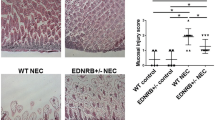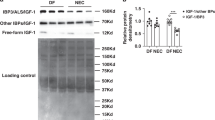Abstract
Purpose
Necrotizing enterocolitis (NEC) is a serious condition, predominantly observed in premature infants. We used an experimental NEC model to investigate the effects of vascular endothelial growth factor (VEGF) cloned into a plasmid.
Materials and methods
Twenty-four newborn Wistar albino rats were randomized equally into three groups as follows: control, NEC and NEC+VEGF. NEC was induced by hyperosmolar enteral formula feeding, exposure to hypoxia/reoxygenation and cold stress. In the NEC+VEGF group, VEGF (1 μg) incorporated into plasmid (2 μg) was administered subcutaneously once daily for a total of 3 days starting on the first day of the NEC procedure. All rats were sacrificed on the 4th day of life, and the specimens were harvested for histopathological and biochemical examinations [including tissue oxidative stress (malondialdehyde and nitric oxide), inflammation (myeloperoxidase, interleukin-6 and tumor necrosis factor alpha) and apoptosis (caspase-3 activity) parameters].
Results
In the NEC+VEGF group, tissue malondialdehyde, nitric oxide, interleukin-6, tumor necrosis factor alpha levels and caspase-3 activity were significantly decreased. In addition, the myeloperoxidase level was increased compared to that of the NEC group (p < 0.05). Histopathologically, VEGF overexpression enhanced angiogenesis, alleviated villous atrophy and tissue edema (p < 0.05).
Conclusion
VEGF overexpression with plasmids seems to be a promising approach in the management of NEC.



Similar content being viewed by others
References
Lin PW, Stoll BJ (2006) Necrotizing enterocolitis. Lancet 368:1271–1283
Hsueh W, Caplan MS, Qu XW, Tan XD, De Plaen IG, Gonzalez-Crussi F (2003) Neonatal necrotizing enterocolitis: clinical considerations and pathogenetic concepts. Pediatr Dev Pathol 6:6–23
Albanese CT, Rowe MI (1998) Necrotizing enterocolitis. In: O’Neill JA Jr, Rowe MI, Grosfeld JL, Fonkalsrud EW, Coran AG (eds) Pediatric surgery, 5th edn. Mosby, St. Louis, pp 1297–1320
Noerr B (2003) Current controversies in the understanding of necrotizingenterocolitis. Part 1. Adv Neonatal Care 3:107–120
Koruda MJ, Rolandelli RH (1990) Experimental studies on the healing of colonic anastomoses. J Surg Res 48:504–515
Thyoka M, de Coppi P, Eaton S, Khoo K, Hall NJ, Curry J, Kiely E, Drake D, Cross K, Pierro A (2012) Advanced necrotizing enterocolitis part 1: mortality. Eur J Pediatr Surg 22:8–12
Nadler EP, Dickinson E, Knisely A, Zhang XR, Boyle P, Beer-Stolz D, Watkins SC, Ford HR (2000) Expression of inducible nitric oxide synthase and interleukin-12 in experimental necrotizing enterocolitis. J Surg Res 92:71–77
Yurdakok B, Canpolat FE, Orhan D, Kale G (2010) Effects of enteral insulin on hypoxic changes in a rat model of necrotizing enterocolitis. Indian Pediatr 47:887–888
Carmeliet P, Jain RK (2011) Molecular mechanisms and clinical applications of angiogenesis. Nature 47:298–307 (Review)
Moore TC, Collins DL, Nguyen M (2002) Marked (24-fold) elevation of peritoneal cavity drainage fluid vascular endothelial growth factor after successful “patch, drain, and wait” approach for extensive midgut necrosis in a newborn. Pediatr Surg Int 18:400–404
Maynard AA, Dvorak K, Khailova L, Dobrenen H, Arganbright KM, Halpern MD, Kurundkar AR, Maheshwari A, Dvorak B (2010) Epidermal growth factor reduces autophagy in intestinal epithelium and in the rat model of necrotizing enterocolitis. Am J Physiol Gastrointest Liver Physiol 299:G614–G622
Wu SF, Caplan M, Lin HC (2012) Necrotizing enterocolitis: old problem with new hope. Pediatr Neonatol 53(3):158–163
van Montfrans C, te Velde AA, van Deventer SJ, Rodriguez Pena MS (2004) Gene therapy in the treatment of intestinal inflammation. Int J Colorectal Dis 19:79–86 (Review)
Giacca M (2007) Virus-mediated gene transfer to induce therapeutic angiogenesis: where do we stand? Int J Nanomedicine 2(4):527–540 (Review)
Hunter CJ, Upperman JS, Ford HR, Camerini V (2008) Understanding the susceptibility of the premature infant to necrotizing enterocolitis (NEC). Pediatr Res 63:117–123 (Review)
Rowland KJ, Choi PM, Warner BW (2013) The role of growth factors in intestinal regeneration and repair in necrotizing enterocolitis. Semin Pediatr Surg 22(2):101–111 (Review)
Downard CD, Renaud E, St Peter SD, Abdullah F, Islam S, Saito JM, Blakely ML, Huang EY, Arca MJ, Cassidy L, Aspelund G (2012) Treatment of necrotizing enterocolitis: an American Pediatric Surgical Association Outcomes and Clinical Trials Committee systematic review. J Pediatr Surg 47(11):2111–2122 (Review)
Patil SD, Rhodes DG, Burgess DJ (2005) DNA-based therapeutics and DNA delivery systems: a comprehensive review. AAPS J 7:E61–E77 (Review)
Scotland G, Beard M, Erdogan S, Huston E, McCallum F, MacKenzie SJ, Peden AH, Pooley L, Rena NG, Ross AH, Yarwood SJ, Houslay MD (1998) Intracellular compartmentalization of PDE4 cyclic AMP-specific phosphodiesterases. Methods 14(1):65–79
Guven A, Gundogdu G, Vurucu S, Uysal B, Oztas E, Ozturk H, Korkmaz A (2009) Medical ozone therapy reduces oxidative stress and intestinal damage in an experimental model of necrotizing enterocolitis in neonatal rats. J Pediatr Surg 44:1730–1735
Uchiyama M, Mihars M (1978) Determination of malondialdehyde precursor in tissues by thiobarbituric acid. Ann Biochem 86:271–278
Moshage H (2009) Simple and reliable measurement of nitric oxide metabolites in plasma. Clin Chem 55:1881–1882
Kruidenier L, Kuiper I, Van Duijn W, Mieremet-Ooms MA, van Hogezand RA, Lamers CB, Verspaget HW (2003) Imbalanced secondary mucosal antioxidant response in inflammatory bowel disease. J Pathol 201(1):17–27
Jonges LE, Nagelkerke JF, Ensink NG, van der Velde EA, Tollenaar RA, Fleuren GJ, van de Velde CJ, Morreau H, Kuppen PJ (2001) Caspase-3 activity as a prognostic factor in colorectal carcinoma. Lab Invest 81(5):681–688
Adas G, Percem A, Adas M, Kemik O, Arikan S, Ustek D, Cakiris A, Abaci N, Kemik AS, Kamali G, Karahan S, Akcakaya A, Karatepe O (2011) VEGF-A and FGF gene therapy accelerate healing of ischemic colonic anastomoses (experimental study). Int J Surg 9:467–471
Barrientos S, Stojadinovic O, Golinko MS, Brem H, Tomic-Canic M (2008) Growth factors and cytokines in wound healing. Wound Repair Regen 16:585–601
Bányász I, Bokodi G, Vásárhelyi B, Treszl A, Derzbach L, Szabó A, Tulassay T, Vannay A (2006) Genetic polymorphisms for vascular endothelial growth factor in perinatal complications. Eur Cytokine Netw 17:266–270
Acknowledgments
We thank to Gulcin Kamali for their contribution to this study.
Conflict of interest
The authors declare that they have no conflicts of interest.
Author information
Authors and Affiliations
Corresponding author
Rights and permissions
About this article
Cite this article
Karatepe, H.O., Kilincaslan, H., Berber, M. et al. The effect of vascular endothelial growth factor overexpression in experimental necrotizing enterocolitis. Pediatr Surg Int 30, 327–332 (2014). https://doi.org/10.1007/s00383-013-3460-z
Accepted:
Published:
Issue Date:
DOI: https://doi.org/10.1007/s00383-013-3460-z




